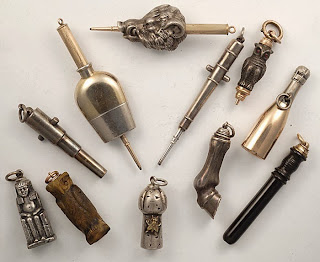Is there a collector who doesn't long for a time machine when looking at old catalogs? Some now-iconic rarities were expensive luxuries when new, but many were not. Studying old catalogs highlights how what is valued now wasn't necessarily what was valued then. Nowadays collectors generally value silver pens far more highly than their gold filled equivalents, for example, but their respective valuation was the exact reverse when they were new.
I recently ran across a particularly dramatic example of this in an Aikin Lambert catalog brochure from the 1880s (the title page features the company's exhibition award medals from Philadelphia [1876], Paris [1878], Sydney [1879], and Melbourne [1880], and D. F. Foley is listed as one of the firm's four principals, so the catalog predates his founding his own firm in Feb 1888). The last page lists a selection of figural novelty pencils -- now very rare and desirable -- and their prices.
A magic pencil in the form of a champagne bottle was only $1.25 in gold plate or celluloid, $2 in sterling silver. Other designs such as bullets, obelisks, bells, and telephones fell into the same range. This was cheap in both absolute and relative terms, as a look at other pages demonstrates.
In the same price range we find your basic small gold-nibbed dip pen in various forms, all of which are in plentiful supply today. For the price of a single run-of-the-mill boxed #1-size dip pen with gold filled holder and pearl taper, you could have had two figural novelty pencils!
Too late now, alas -- the exchange rate has changed rather dramatically in the last 130 years. The novelty pencils shown above are all American made, though not all are Aikin Lambert products.
ADDENDUM: The brochure was printed by the prominent New York firm of Mayer, Merkel & Ottmann, at 21-25 Warren Street (name and address in the bottom margin of the back cover). This helps narrow the date, as the two senior partners retired in 1885, the company continuing as the J. Ottmann Lithographing Company.
A blog about antique and vintage writing instruments: fountain pens, mechanical (propelling) pencils, dip pens, and more.
Sunday, October 27, 2013
Friday, October 11, 2013
Stylomine 303 self-filling safety
After an absence of too many years, I was back in Europe last week for the Hamburg and London pen shows. Travel is broadening when it comes to collecting, too. Had I never left the USA, I would probably never have learned about the pen featured here -- nor, finally, have had the opportunity to acquire one.
While to all outward appearances a normal black hard rubber French safety, it is nothing but. Instead of a turning knob at the end of the barrel, there is a blind cap. Turn it counterclockwise -- the opposite direction the end knob of a safety is turned -- and the nib extends from the barrel. Keep turning, and the blind cap comes off, revealing a rubber bulb. No eyedropper required: this safety can be filled from a bottle by itself. Note that the barrel threads are set back from the barrel mouth more than is usual, allowing the mouth to be dipped into ink for filling without getting ink into the threads.
As far as I know, these pens were sold almost entirely in France, yet they are very rare even there. A solution in search of a problem, perhaps -- but a wonderful bit of gadgetry! Coincidentally, a European pen friend was able to acquire another example just a couple of weeks ago, in mottled hard rubber with a gold filled overlay.
While to all outward appearances a normal black hard rubber French safety, it is nothing but. Instead of a turning knob at the end of the barrel, there is a blind cap. Turn it counterclockwise -- the opposite direction the end knob of a safety is turned -- and the nib extends from the barrel. Keep turning, and the blind cap comes off, revealing a rubber bulb. No eyedropper required: this safety can be filled from a bottle by itself. Note that the barrel threads are set back from the barrel mouth more than is usual, allowing the mouth to be dipped into ink for filling without getting ink into the threads.
As far as I know, these pens were sold almost entirely in France, yet they are very rare even there. A solution in search of a problem, perhaps -- but a wonderful bit of gadgetry! Coincidentally, a European pen friend was able to acquire another example just a couple of weeks ago, in mottled hard rubber with a gold filled overlay.
Wednesday, October 9, 2013
A Gorham pen with a twist
Dip pens by Gorham often have a bold helical pattern, but normally all in sterling silver. This pen combines the usual silver with ivory, to stunning effect. I've not seen another example, though I do have an unmarked pen of very similar construction combining silver with wood instead of ivory.
Subscribe to:
Posts (Atom)



